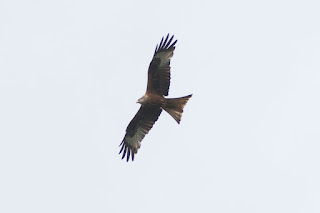Never been to Warburg near Henley, but we will be going back again, its a great place. Couple of Red Kites circling overhead as we got going, and a single Wood White fluttered past in the car park.
Met one of the local visitors photographing some of the Common Spotted Orchids, and some of the other abundant flora and he gave us a few guidelines. Did not take long to get onto the first Greater Butterfly Orchid colony. Shame the nettles were at face hight. A Marsh Tit doing a good buzzy impersonation of a Willow Tit was a bit of a bonus. It was stocking up on grubs, so a nest must have been nearby.
Not too far away we found a very nice area of short grazed turf full of Common Twayblades. Looked promising for snakes and lizards too, but could not find any-it was still a bit cool.
On the return leg, I searched a large area of Beech wood hoping to find Birds Nest Orchids, but without success. However, after a chat to the wardens in the centre, and a quick visit to see the Fly Orchids in the garden we eventually got onto a small colony. Compared to the ones we saw last year, these were a lot bigger and in more open woodland. We also found a single White Helleborine.
Thinking that the recent rain and warm weather would have helped with some of the downland species, we headed off to Noar Hill near Selbourne, with the interesting sight of a Honey Buzzard circling a wood on the way down.
Plenty of White Helleborines in the scrubby woodland, and Common Spotted and Common Fragrant Orchids were abundant. The Pyramida'ls were largely in bud and as it turned out, the Musk Orchids (among others) were yet to get going. Lots of Common Blue butterflies, as well as Small Heath and Large Skippers. A Dingy Skipper posed for us.
We eventually got to Whitecross Green mid afternoon, but worryingly the weather still looked a bit uncertain with plenty of cloud and a cool wind at times. On the way down to the main area, a female Red Deer was a bit of a surpirise-as it slipped back into the wood it flushed a Little Owl.We eventually got down to the mown section of the ride and sat down, not expecting anything to happen. However, during the brief sunny periods something like ten Black Hairstreaks could be seen at the top of the Blackthorn bushes and the small Oak trees. Occasionally one would come lower, but not into camera range. On our return, we bumped into several parties who had been concentrating on another area. This had a few Honeysuckle and Rose flowers for the Hairstreaks, but though they would come down to feed occasionally, it did not happen while we were there, and they were still too far away for the camera anyway.
On the return leg, I searched a large area of Beech wood hoping to find Birds Nest Orchids, but without success. However, after a chat to the wardens in the centre, and a quick visit to see the Fly Orchids in the garden we eventually got onto a small colony. Compared to the ones we saw last year, these were a lot bigger and in more open woodland. We also found a single White Helleborine.
Thinking that the recent rain and warm weather would have helped with some of the downland species, we headed off to Noar Hill near Selbourne, with the interesting sight of a Honey Buzzard circling a wood on the way down.
Plenty of White Helleborines in the scrubby woodland, and Common Spotted and Common Fragrant Orchids were abundant. The Pyramida'ls were largely in bud and as it turned out, the Musk Orchids (among others) were yet to get going. Lots of Common Blue butterflies, as well as Small Heath and Large Skippers. A Dingy Skipper posed for us.
We eventually got to Whitecross Green mid afternoon, but worryingly the weather still looked a bit uncertain with plenty of cloud and a cool wind at times. On the way down to the main area, a female Red Deer was a bit of a surpirise-as it slipped back into the wood it flushed a Little Owl.We eventually got down to the mown section of the ride and sat down, not expecting anything to happen. However, during the brief sunny periods something like ten Black Hairstreaks could be seen at the top of the Blackthorn bushes and the small Oak trees. Occasionally one would come lower, but not into camera range. On our return, we bumped into several parties who had been concentrating on another area. This had a few Honeysuckle and Rose flowers for the Hairstreaks, but though they would come down to feed occasionally, it did not happen while we were there, and they were still too far away for the camera anyway.








